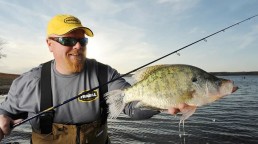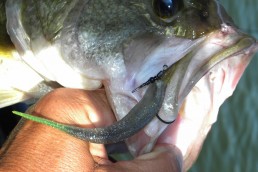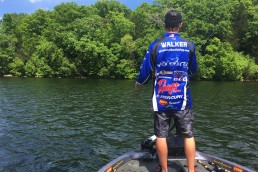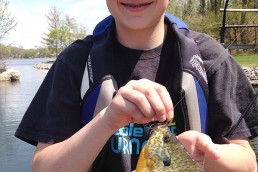Drop-shot Rigging Techniques for Panfish
SHARE THIS POST
with Ted Pilgrim
Amazing that such a versatile rig—this prefect presenter of soft plastics and live bait—would be so little employed by panfish fans. In reality, a drop-shot rig can be as productive as a bobber and bait, or even a tiny jig. It’s even possible that the drop-shot is the most versatile rig of all, providing instant depth control, fishes heavy without impairing or impeding the presentation, shines in shallow and deep water, and activates softbaits like no other presentation.
Despite the rig’s “advanced” connotation, the drop-shot couldn’t be simpler. Think split shot rigs in reverse. As a softbait delivery method, the drop-shot excels for bass. So it’s no surprise that small baits twitched and wiggled in new and tantalizing ways hold equal appeal for crappies, sunfish and big perch. If you can cast, you’re in. If you can tie a Palomar knot, you can master a drop-shot rig.
Drop-shot baits
Tons of small softbaits now give panfish anglers an arsenal of sweet options. Yet, while shapes like twister tail grubs excel on a jig, a drop-shot activates straight tail worms, minnows and other subtle shapes. Moreover, many classic softbait shapes traditionally threaded onto 1/8- to 1/64-ounce jig heads spring to new life when pinned to a plain hook above a sinker.
Consider the Custom Jigs & Spins Wedgee, a lively microbait “twitcher” that marries perfectly with a drop-shot. Impaled onto a #10 or #12 short-shank hook above a drop-shot sinker, the Wedgee and other wispy sliver-tail baits can be almost magical for palm-stretching pans. Deployed with a 1/4- to 3/8-ounce weight, these tiny morsels move with spellbinding action. Other microbaits like Custom Jigs & Spins Finesse Plastics and Noodel and Northland Tackle’s Impulse Bro Bloodworm perform truly captivating dropshot dances.
Anything with nice, soft appendages and a fine quivering tail is a potentially perfect drop-shot enticement. So long as you can nose hook it on a #6 to a #12 fine-wire hook, such as an Eagle Claw L2B, nearly any miniature morsel can be made to tempt bites, including live bait.

“Anytime I need to put a bait at an exact level and keep it in the fish’s face,” contends guide and panfish pioneer Brian “Bro” Brosdahl, “a drop-shot is priceless. Not only can I cast and simply twitch it in place, I can also drag the rig, swim it, troll it or even work it vertically beneath the boat or a hole in the ice.”
As with any presentation, of course, limitations exist. Shallow, dense, cover areas, such as thick vegetation or brush are largely off limits. Fish suspended higher than three feet above bottom are also better served with other approaches. But even this situation has exceptions. When crappies or sunfish suspend in treetops or sparse brush deep enough to fish vertically beneath your boat, a dropshot can be the perfect presentation.
Are you enjoying this post?
You can be among the first to get the latest info on where to go, what to use and how to use it!
Rigging the drop
Based on countless cover, depth and other conditions, a well-armed drop-shot can be built with an array of possible componentry. “To detect bites,” says Bro, “I use a 4- to 8-pound test braided mainline, joining it to an 18- to 36-inch section of mono or fluorocarbon, using back-to-back Uni knots or an Improved Albright knot.” Often, when hunting fish within a foot of bottom, Bro says, an 18-inch length of 4- to 6-pound test mono is perfect.
The most critical aspect of the drop-shot is tying the Palomar knot so the hook-point faces up. Bro interjects that an exception to the standard drop-shot rig often becomes necessary with light-biting fish.
“Big bluegills often mouth a softbait like humans taste red hot food. So it’s sometimes best to rig with a short dropper, or pair of droppers jutting from the mainline, as opposed to pinning the bait to the line with a Palomar.” Beyond the obvious advantage of allowing fish to more easily flush a bait entirely into its craw—thanks to the semi-slack dropper line—Bro also extols the “flutter factor.”
“Once the sinker hits bottom,” he says, “a short 3- to 8-inch dropper gives your bait a nice fluttering effect—more movement—as the dropper and bait slowly descend to catch up. I also like that a dropper gives baits a little extra whipping action when you move the rod-tip.”
Situational droppin’
“It’s the best rig there is for fishing just inches above low growing grass or small rocks, keeping a bait clean and at eye-level with the fish,” Bro asserts. “With a 1/4-ounce sinker and 4-pound test, I can even get down to 20 feet of water fast, and fish with finesse and precision. In flooded trees and bushes, I’ll position my boat directly above a school of fish, and slide the rig down to a certain level—tops of the trees or mere inches above the level of fish I’m marking on the Humminbird. With Spot-Lock engaged on my iPilot, I’ll hover directly above and simply shake the rod tip to activate the bait’s tiny tail. The control you have with this presentation is unbelievable.”
For casting to shallow spring panfish, a drop-shot can be powerful medicine. “Fish that have just moved up onto shallow flats aren’t really active yet. I use a 7-foot St. Croix Panfish Series rod to pitch a compact drop-shot rig past the fish and slowly work it into position. Once there, give the rod-tip periodic nervous shakes, so the sinker stays put, but the bait’s little tail quivers like a defenseless invertebrate, inches above bottom.
“A drop-shot is absolutely beautiful for putting a bait at the fish’s eye level—right where they’ve got no choice but to eat it.”
MWO
SHARE THIS POST
Did you enjoy this post?
You can be among the first to get the latest info on where to go, what to use and how to use it!
Brian 'Bro' Brosdahl
Outdoor communicator Brian “Bro” Brosdahl lives in northern Minnesota. He is a walleye guide in the Cass Lake, Leech Lake and Lake Winnibigoshish areas. He is sponsored by Northland Fishing Tackle, Frabill/Plano, Aqua-Vu, Humminbird/Minn Kota, St. Croix Rods, Ranger Boats, and Evinrude. Guide inquiries: brosguideservice.com. Follow on social media.




[…] Source […]